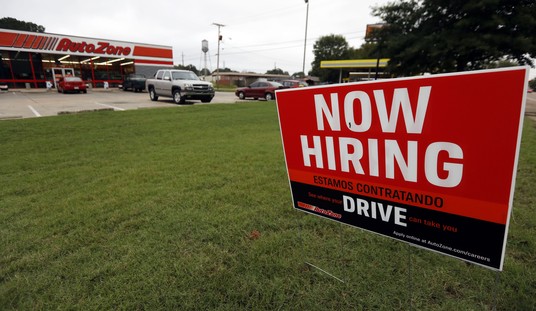Don’t expect Wall Street to perk up over the latest economic indicators released by the Obama administration. Retail sales figures for July show a 0.4% increase over June, which fell 0.3% in relation to May (adjusted from the earlier report of -0.5%). This mildly good news masks the fact that the gains were concentrated in gasoline and auto sales, and that retail sales fell in the broad market in July:
Retail sales managed a modest increase in July after two consecutive declines, but the strength was concentrated in higher sales of autos and gasoline. Most other retailers saw their sales fall.
Sales rose 0.4 percent last month and sales excluding autos climbed 0.2 percent, the Commerce Department said Friday.
The broad declines outside of auto and gas sales offer more evidence of a slowing recovery. The concern is that spending will slow further in the second half of this year as households struggle with high unemployment and lackluster job growth.
The return of positive numbers for auto sales came amidst a large amount of promotions and relaxed credit, increasing the sales costs for auto dealers and manufacturers. That will help topline numbers for the industry but eventually limit bottom-line profit, and it also suggests that the normal summer clearance activity may need more help than usual.
Without cars and gasoline — which increased in sales mainly because of price increases in summer vacation season — the actual performance was worse than last month:
Excluding auto sales and gas, retail sales would have fallen 0.1 percent in July. That compares with a 0.2 percent increase in June when excluding autos and gasoline.
The July figures reflected widespread sales declines. Sales were down 1 percent at department stores and also dropped at specialty clothingstores, furniture stores, hardware stores and appliance stores.
In what is probably not a coincidence, real wages began to fall in July as well:
Real average hourly earnings for all employees fell 0.2 percent from June to July, seasonally adjusted, the U.S. Bureau of Labor Statistics reported today. This decrease stems from a 0.2 percent increase in average hourly earnings combined with a 0.3 percent increase in the Consumer Price Index for All Urban Consumers (CPI-U).
Real average weekly earnings rose 0.2 percent over the month, as a result of a 0.3 percent increase in the average work week combined with the decrease in real average hourly earnings. Since reaching a recent low in October 2009, real average weekly earnings have risen 2.0 percent. …
Real average hourly earnings for production and nonsupervisory employees fell 0.2 percent from June to July, seasonally adjusted. This result stemmed from a 0.4 percent increase in the Consumer Price Index for Urban Wage Earners and Clerical Workers (CPI-W) while average hourly earnings rose 0.1 percent.
In other words, hours and wages aren’t keeping up with the very mild level of inflation in the economy. That’s to be expected as demand drops and productivity declines, so this isn’t exactly a surprise. It is another indicator that we’re sailing into stagnation rather than surfing the waves of Recovery Summer.
Update: Reuters’ headline writer tries to keep up the administration spin with “Retail sales rebound in July,” but the article is more circumspect:
Retail sales rose in July in a hopeful sign for the economy, but the gains were concentrated in auto and gasoline station sales, suggesting underlying momentum in consumer spending remains tame.
If by “tame” Reuters means “declining,” then they’re on the same page as the AP — and reality.
Bloomberg wasn’t as sanguine:
Sales at U.S. retailers rose less than forecast in July, indicating a lack of jobs is prompting Americans to hold back on spending.
The 0.4 percent increase, led by autos and gasoline, followed a revised 0.3 percent drop in June, figures from the Commerce Department in Washington showed today. Economists projected a 0.5 percent gain, according to the median estimate in a Bloomberg News survey. Excluding auto dealers and gasoline stations, purchases fell 0.1 percent.
Retailers may need to step up discounting unless job growth picks up and rekindles consumer spending, which accounts for 70 percent of the economy. Federal Reserve policy makers said this week that the recovery was likely to be “more modest” than earlier anticipated.
Jobs are the key, and it’s the area hardest hit by Obama’s economic policies. (h/t DogSoldier)









Join the conversation as a VIP Member